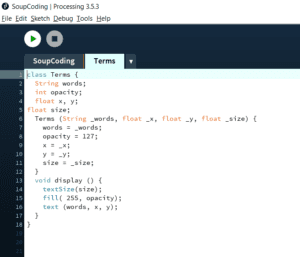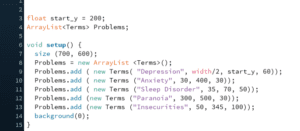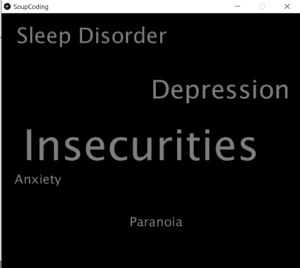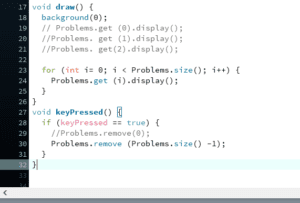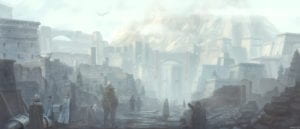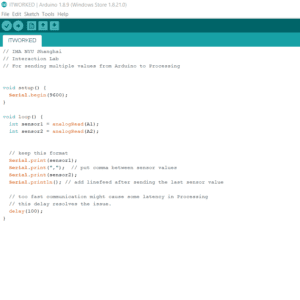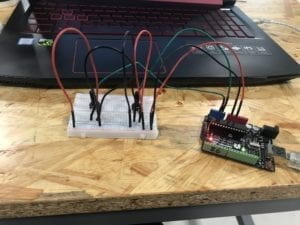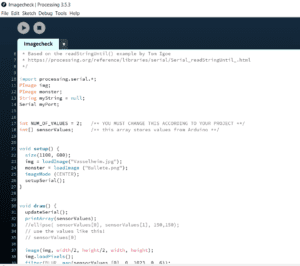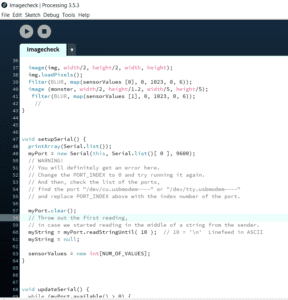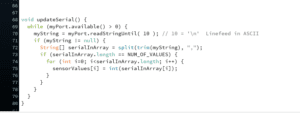Your Adventure in Sounds and Words (Turned Exploration into Reading) – Monika Yosifova- Rodolfo Cossovich
Conception and Design:
Since we had to use both Arduino and Processing, it felt as though for this Final Project, one must have a physical object with Arduino which would interact with something on a computer screen through Processing. Originally, I thought it shouldn’t be too difficult to create an object that people would want to come up to and play around with. The Adventure in Sound and Words that I designed alongside Alison Frank turned out to work as a concept, but the design was much more difficult to execute properly. We put the Arduino components inside of a wooden, laser-cut box which we then painted over in order to make it look more unique and interesting. A definite problem with the design was that we chose to use distance sensors in order to measure a user’s interaction with the Arduino. Distance sensors are extremely sensitive to movement, and if a user didn’t have a steady hand, the story which they were experiencing on the monitor would skip through slides. This was annoying, and perhaps we should’ve used buttons instead of the sensors. I didn’t want to; since some of the feedback I was given from my previous project was that I should’ve used sensors instead of buttons… It was one of those decisions where you had to pick one or the other, stick with it and hope for the best.
Probably the biggest design problem that we encountered, even bigger than the sensors, was the difficulty of writing text which people would spend their time reading as they interacted with the Arduino. As we tested people through our project after user-testing, we found that they didn’t read the full story on the screen, and instead just followed the instructions at the bottom. For a project that was originally meant to be an entertaining story-telling experience, this ruined it entirely. BUT, it was a very interesting discovery. Not all people actually enjoyed reading, and this meant that the product we were creating wasn’t for everyone.
When we realized this, my partner and I were completely blown away, and made a last-minute change to a Final Project Concept, adding in a sign made out of cardboard box which says “I didn’t read SO I DIED” to the project. It was a tribute to all of those times we didn’t fully read the Recitation Instructions in class or just skipped through the guiding instructions of our Tests. It was a little physical form of punishment which we wanted to give to those that didn’t value the story which they were reading. It was effective, because it let us explore our project in a very different direction.
Fabrication and Production:
One of the most significant steps in the production process of our project was originally the design of the box which we printed in order to cover the Arduino. We made a 39×29 cm box with a height of 8cm, which was lasercut and then put together with hot glue. We designed, with the help of the lab assistants, two 6×2.5 cm rectangular holes through which we stuck through our distance sensors. Everything underneath the box, aka the Arduino, sensors and cables, were stuck onto the bottom of the box with strong scotch tape, because paper tape was too weak to hold the breadboard and Arduino. Once this was created, Alison and I didn’t want to leave the wooded box bare, and spent a bit of time deciding what color and design to put upon it. Ultimately we chose a dark brown-black background color, as it was going to be placed on top of my laptop, and we wanted it to attempt to blend in, as if they were one structure. Then, because the background was too simple, I took the basic dragon design from the Dungeons and Dragons logo (a tabletop roleplaying game) and drew it onto the box in white. It was representative of the fact that Dungeons and Dragons partially inspired my production of Your Adventure in Sounds and Words. The laser-cut box was wonderful, very different from the two-minute makeshift cardboard box which Ali and I used for User-testing. That one was truly just a small cardboard box over which I color printed a Dungeons and Dragons print, stuck it with glue and cut out two small holes for our sensors. It was a prototype that did the job, but ultimately the final product box was much better.
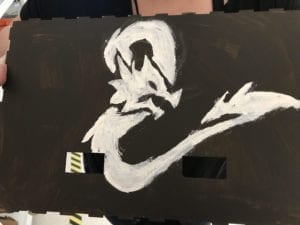
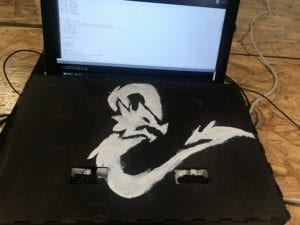
Conclusions:
Your Story in Sound and Words was intended as a short single-player roleplaying videogame which anyone could just play when they wanted to escape everyday stress for five minutes of their day. Interaction for me was the ability for two actors to interact where one can take in information, process it and then output their own information. It worked to an extent, as people were capable of making choices in their in-game journey and therefore reaching different outputs of information as they went along in the short game. The game was interactive to an extent, but it wasn’t interactive to the level of being angle to properly and fully communicate with another person because all of the choices were pre-determined. Based on my definition of interaction, my audience interacted with my project in a decent way. Some users didn’t wish to read the information that was given to them on the screen, and therefore weren’t interacting with the story and the project as a whole how they were supposed to. This taught me that it is possible that what you create may not be universally as interesting for everyone. My product was for a niche of people who enjoyed reading, and those who didn’t would interact with the project in a way where their hand motions were much more valuable than the full input they received in return
I think this project shows an interesting split in society, between people who enjoy reading and those who don’t. It makes me curious as to what the actual societal percentages of these are, even though it is quite impossible to account for the full world’s opinion. It makes me wonder if those people who don’t like to read are those who are those that cannot afford to “escape” their everyday lives even for a little bit. No, that doesn’t seem correct. There is some very interesting correlation and deeper meaning between those people who consider reading an interaction of brain and book, and those who just skim-read in order to “get on” with things faster.
Thank you!
